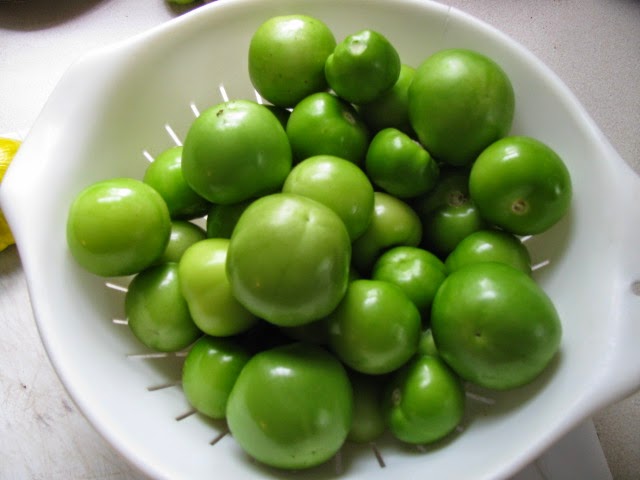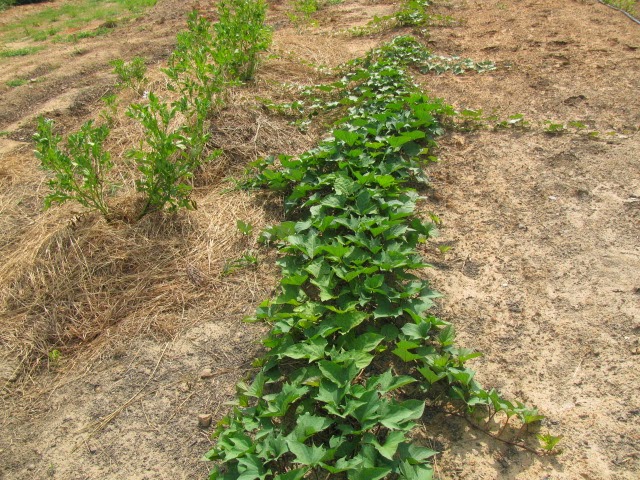Making your own sturdy, inexpensive trellis for cucumbers, peas, pole beans and so forth is not difficult to do. With this method, which is quite common and not any sort of innovation on my part, works very well, can be easily made in any height and width to fit your space and your needs. Notice on this photo of the finished trellis that it is not perfect.
The strings are knotted 'approximately' where they need to be. The
cucumbers don't care and soon enough the vines will completely cover the
trellis hiding all those annoying imperfections. Don't let perfection
be the enemy of the good when it comes to this project.
1. Install a post at each end of your row to support your trellis. I
use T-posts about 8 feet apart. How far apart the posts can be depends
on the strength and tightness of the top horizontal support. I use
heavy gauge baling twine, which can be made very tight, stretches very
little and therefor does not sag easily. I could probably go 10-12 feet
apart.
 |
| The finished trellis |
2. Attach your top string between the end posts at the height you want. Make sure it's really tight. The top of my trellis is at 5 feet. Cut pieces of twine twice the height plus 4 feet - so I cut the twine pieces 14 feet long each. Fold a string in half, loop it around the top string and bring the cut ends of the twine through the loop. tighten the looped knot on the top string. You will have a pair of twine pieces dangling from each each loop knot. Place twine pairs about 6 inches apart all along the top string with the first and last pairs right next to the end posts.
 |
| looped twine attached to top string |
 |
| All the twine attached to the top string |
3. Think of the dangling twine pieces as numbered. Working from left to right, the first two dangling strings are no. 1 & 2, the next pair 3 & 4, next 5 & 6 and so forth. Forget string no. 1 for the moment. Take no. 2 and no. 3 and tie them in a knot about 6 inches below the top string to make a triangle. Be sure to knot the strings using a 'square knot'. "Right over left - Left over right". That way the knots will not slip.
 |
| String no. 1 still dangling and string no. 2 & 3 knotted together |
Knot together all the string pairs -- 2-3, 4-5, 6-7, 8-9,........etc., forming triangles across the top string ending with the last string dangling next to the far post.
 |
| Step 3 completed. All the pairs knotted and last string dangling at the end post |
4. OK - next row. Take string no. 1 and wrap it around the back side of the end post and knot it to string no. 2 at a point 12 inches down from the top string for string no. 1 and 6 inches below the knot for string no 2. After that, knot together the pairs of strings 6 inches below the knots above -- 3-4, 5-6, 7-8, 9-10, .........etc., forming a diamond pattern. At the far end, wrap the last string round the back of the end post and knot it 12 inches below the top string and 6 inches below the knot above for the next to last string.
 |
| 2nd row completed. Notice the last string wrapped around the post |
5. Repeat the knotting pattern row after row until you get close to ground level. Row 3 - knot together strings 2-3, 4-5, 6-7, etc., six inches below the knot above, ignoring the first and last strings. Row 4 - knot together strings 1-2, 3-4, 5-6, etc., six inches below the knots above, being sure to wrap the first and last string around the end post before knotting it 12 inches below the knot above. For a 5 foot high trellis you will have about 10 rows.
 |
| end post showing the first string wrapped around the post at every other row |
When you knot enough rows to reach close to the ground you will have a foot or so of dangling twine at the bottom. It is not necessary to have the trellis reach all the way to the ground. In fact - it's not good if it does. It makes weeding, cultivating, mulching and so forth, more difficult if it does. You can just let the loose ends of twine just dangle or cut them off about an inch below the bottom row of knots, which again, makes working around the young small plants easier, I think. I run a bottom string of the heavy duty baling twine between the end posts, weaving it in and out the bottom row of diamonds. This is optional but makes for a neater finish.










































